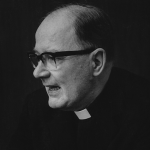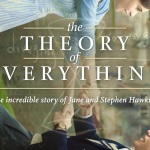Why the Ultimate Cause of Everything in Existence Must be God
by Fr. Robert Spitzer
Filed under The Existence of God
(NOTE: This it the third of a three part series on Bernard Lonergan's philosophical proof for God. Be sure to read the first part and second part.)
V. The One Unrestrictedly Intelligible Uncaused Reality is an “Unrestricted Act of Thinking”
We will now explain Lonergan’s contention that unrestricted intelligibility can only occur through an unrestricted idea, which in turn can only occur through an unrestricted act of thinking.
As noted above, the one uncaused reality that exists through itself is unrestricted in its intelligibility. This means that it can answer from within itself not only the question “Why is it so?” but also all other questions grounded in this question for explanation. For Lonergan, this kind of intelligibility cannot be material (conditioned by space and time) or individuated (restricted to an instance and therefore unable to unify or relate distinct or opposed objects). It must therefore be trans-material and trans-individual – having the qualities of an idea. In order to explain what Lonergan means by “idea,” it will be helpful to distinguish between two kinds of thinking – “picture thinking” and “conceptual thinking.” Picture thinking results in what is called “perceptual ideas” – ideas which correspond to an individual image (such as my dog Fido), and “conceptual thinking” corresponds to conceptual ideas, which require more explanation.
Look at the words in the previous two paragraphs. How many of them correspond to an individual image (like my dog Fido)? As you can see, the vast majority of them do not correspond to any individual image. Instead they correspond to concepts which designate groups of objects and even groups of groups. Thus they can be conjunctions, prepositions, logical terms, mathematical terms, verbs, adjectives, abstract nouns, etc. How are these abstract “group” concepts formed? By placing perceptual and conceptual ideas into relationships with each other. Though some animals are capable of forming perceptual ideas, humans alone are capable of forming conceptual (“relationship based”) ideas.1 So how do we form conceptual ideas that can stand for groups of objects and groups of groups? How do we form relationship-based ideas that do not directly refer to perceptual objects? How do we form ideas that can be used as predicates, objects, and grammatical, logical, and mathematical constructs? In a word, “heuristic notions.”
Notions are general inclusive concepts, and heuristic notions are among the highest of these inclusive concepts. They are capable of unifying (bringing together) all other less general concepts under their broad and inclusive intelligibility. These high-level unifying concepts enable humans to create superstructures through which to interrelate perceptual ideas among one another, perceptual ideas with conceptual ideas, and conceptual ideas among one another. These superstructures are like context for organization of particular ideas – like a map is a context for organizing specific places or a clock or calendar for organizing specific times, or a table of genus and species for organizing similarities and differences among realities, etc. Each superstructure has particular heuristic notions (high-level ideas) intrinsic to it that determine the way in which ideas are to be organized and interrelated.
For example, the notions of “similarity and difference” are essential for interrelating answers to the question, “What is it?” The notions of “here and there” are essential for interrelating answers to the question “Where?” The notions of “earlier-now-later” are essential for interrelating answers to the question “When?” And the notions of “causation-possibility-necessity-contingency-actuality” are essential to organizing answers to the question “Why?” Without heuristic notions to give intelligibility to organizational superstructures, we would have no way of relating ideas among one another, and if we could not do this, we would have no conceptual ideas. We would be reduced to about 4% of the words we use – limited only to those having direct pictorial referents.
Heuristic notions cannot be learned from the empirical world because we would have to use them in order to learn them. Recall that notions are necessary for transforming our perceptual ideas from the empirical world into conceptual ideas, and that notions are the highest-level conceptual ideas. Thus we are confronted with a paradox. We would have to use the very notions that we have not yet learned from the empirical world to translate our perceptions from the empirical world into notions – we would have to use them before we learn them so that we could learn them – an obvious impossibility. They must therefore be innate. Lonergan believes that all such heuristic notions are derived from the supreme heuristic notion – the notion of completely intelligible reality (what he terms “the notion of being”).2
Bearing this in mind, we may now examine the function of heuristic notions. We use them to create organizing superstructures to relate perceptual ideas among one another, relate perceptual ideas with conceptual ideas, and relate conceptual ideas among one another. Let’s return to the heuristic notions of “here,” “there,” and “where.” Notice that these notions provide a superstructure (like a map) for relating one location to another location. Without this superstructure, we would not be able to understand location—because location requires interrelating the data of experience. Thus, perceptual ideas alone cannot make location intelligible. Similarly, the notions of “similarity,” “difference,” and “What?” enable us to create an organizational superstructure to relate one kind of object with other kinds of objects. Again, without these notions (and the superstructure they organize), we would not be able to understand various kinds of objects because perceptual ideas alone (unrelated to each other) do not reveal similarities and differences among objects.
The human mind with its innate heuristic notions is not limited to relationships among perceptual ideas; it can also organize relationships among conceptual ideas. This gives rise to second level abstractions (such as particular conjunctions – “and,” “or,” etc.) and particular prepositions (such as “here,” “around,” “below,” etc.), and third level abstractions (such as the concept of “conjunction” and “preposition”). The mind can generate higher and higher levels of abstract ideas in language, logic, mathematics, and metaphysics. Some of the higher levels of logic are manifest in the complex operators of contemporary modal logic; higher level mathematical concepts may be found in tensor geometry and the mathematics of higher dimensional space; and higher level metaphysical concepts are manifest in the ideas of space, time, reality, intelligibility, causation, and unrestricted intelligibility.
Notice that no conceptual ideas can exist in the physical world, because physical realities are limited by individuation and space-time particularity. Conceptual ideas transcend individuality and space-time particularity, and require the power of mentation (mind)—with its capacity to relate perceptual and conceptual ideas—to achieve this status.
Let us review – humans move from the domain of individual things and individual images (perceptual ideas) to the domain of conceptual (relational) ideas through the use of heuristic notions (high-level ideas that act as superstructures to organize relationships among perceptual and conceptual ideas). These conceptual ideas go far beyond the domain of individual material objects and perceptual ideas, because they contain relational contents that underlie the whole of language, logic, mathematics, metaphysics, and every science and discipline that uses them. Conceptual ideas, then, are vehicles to convey not only meaning, but the intelligibility of reality. Such ideas cannot come from the world of material things; they must come from the domain of mind (thinking) in which heuristic notions organize relationships among individual perceptual ideas and the conceptual ideas derived from them.
We may now proceed to the main point of this section – that the unique unrestrictedly intelligible uncaused reality is an unrestricted act of thinking. Recall from Sections I – IV that an uncaused cause existing through itself (necessary for everything else to exist) must be unique and unrestrictedly intelligible. What kind of being has unrestricted intelligibility? As can be seen from the above analysis, it cannot be something physical or material which is limited by individuality and space-time particularity. Furthermore, it cannot be something which is merely abstract (such as a conceptual idea) because an abstraction is restricted by the ideas from which it is derived. Moreover, it cannot be a restricted act of thinking (which can still inquire) because a restricted act of thinking by definition is not unrestrictedly intelligible. Well then, what is a reality with unrestricted intelligibility? It must be an unrestricted act of thinking (mentation) which grasps everything about everything – every relationship among things and relations – the complete set of correct answers to the complete set of questions. Lonergan puts it this way (using “act of understanding” in the same way I have been using “act of thinking”):
…[I]ntelligibility either is material or spiritual [immaterial] or abstract: it is material in the objects of physics, chemistry, biology, and sensitive psychology; it is spiritual [immaterial] when it is identical with understanding; and it is abstract in concepts of unities, laws…. But abstract intelligibility necessarily is incomplete, for it arises only in the self-expression of spiritual intelligibility. Again, spiritual intelligibility is incomplete as long as it can inquire. Finally, material intelligibility necessarily is incomplete, for it is contingent in its existence and in its occurrences, in its genera and species… moreover, it includes a merely empirical residue of individuality, noncountable infinities, particular places and times…. It follows that the only possibility of complete intelligibility lies in a spiritual intelligibility that cannot inquire because it understands everything about everything.3
So what is an unrestricted act of thinking like? Let’s begin with what it is not. An unrestricted act of thinking cannot occur through a material brain because a material brain cannot accommodate unrestricted intelligibility since it is restricted in both its intelligibility and its material functioning. The same can be said for artificial intelligence, which also is restricted in its intelligibility and material (electromagnetic, electrochemical, or even biochemical) functioning. Indeed, we will have to eliminate any apparatus, power, or activity which is in any way material or restricted in its power to ground intelligibility.
This means that an unrestricted act of thinking must be a power which is capable of bringing together, in a single act, the interrelationship among unrestricted intelligibility and all restricted intelligibility. What kind of power could this be? It must be a power that can be in relationship to itself and anything extrinsic to itself – a power which is not restricted by a spatial or temporal manifold; a power which has no intrinsic limitations or extrinsic restrictions that would prevent it from being unrestricted in its intelligibility; a power that can act as a unifying agent of every restricted reality and idea as well as for itself; a power which can be completely self-reflective, self-appropriating, self-conscious, and self-transparent because it has no intrinsic restriction preventing it from being present to itself and everything distinct from itself (the whole domain of restricted reality and intelligibility).
This pure mentative power cannot be imagined (i.e., picture thinking), because that would subject it to individuation as well as space and time (which it completely transcends). We can only approach it through an appreciation of its unrestricted and self-transparent unitive and unifying power. Any attempt to further refine this notion will only serve to restrict and particularize it – which would render our conception false.
For Lonergan, then, the only possible source of complete intelligibility is an unrestricted act of understanding – what we have called an unrestricted act of thinking – an unrestricted power capable of comprehensive unification of itself (unrestricted intelligibility) with the whole of restricted intelligibility in a completely self-transparent self-reflective act. This unrestricted mentative power is the ultimate cause of everything else in existence – including restricted powers of mentation (like ours). For this reason, Lonergan refers to it as “God.”
VI. Conclusion
We began this proof with showing the necessity for at least one uncaused reality that exists through itself – without which nothing would exist. We then proceeded to show that such a reality would have to be unrestricted in its explicability and intelligibility. We then showed that an unrestrictedly intelligible reality could only be one – absolutely unique – and then showed that this one unrestrictedly intelligible uncaused reality would have to be the ultimate cause (Creator) of everything else in reality. We then asked what an unrestrictedly intelligible reality would be like, to which we responded that it could not be a physical reality, an abstract idea, or a restricted power of mentation. This left only one remaining option – an unrestricted power of mentation which is described above. These proven attributes – unique, unrestrictedly intelligible, uncaused reality existing through itself, which is the Creator of everything else in reality and an unrestricted mentative power—may refer to “God.” Inasmuch as a denial of the above proof entails either a contradiction of fact (i.e. that nothing exists) or an intrinsic contradiction (e.g. an unrestrictedly intelligible reality which is restricted in its intelligibility), we may conclude that “God” as defined, exists.
Notice that this “God” is a metaphysical God – which emphasizes “what God is” – the attributes of God – but does not emphasize “who God is” – “the heart of God.” If we are to answer the latter question, we will have to go beyond the domain of reason, logic, and experience – and delve into the domain of revelation.
Related Posts
Notes:
Note: Our goal is to cultivate serious and respectful dialogue. While it's OK to disagree—even encouraged!—any snarky, offensive, or off-topic comments will be deleted. Before commenting please read the Commenting Rules and Tips. If you're having trouble commenting, read the Commenting Instructions.













